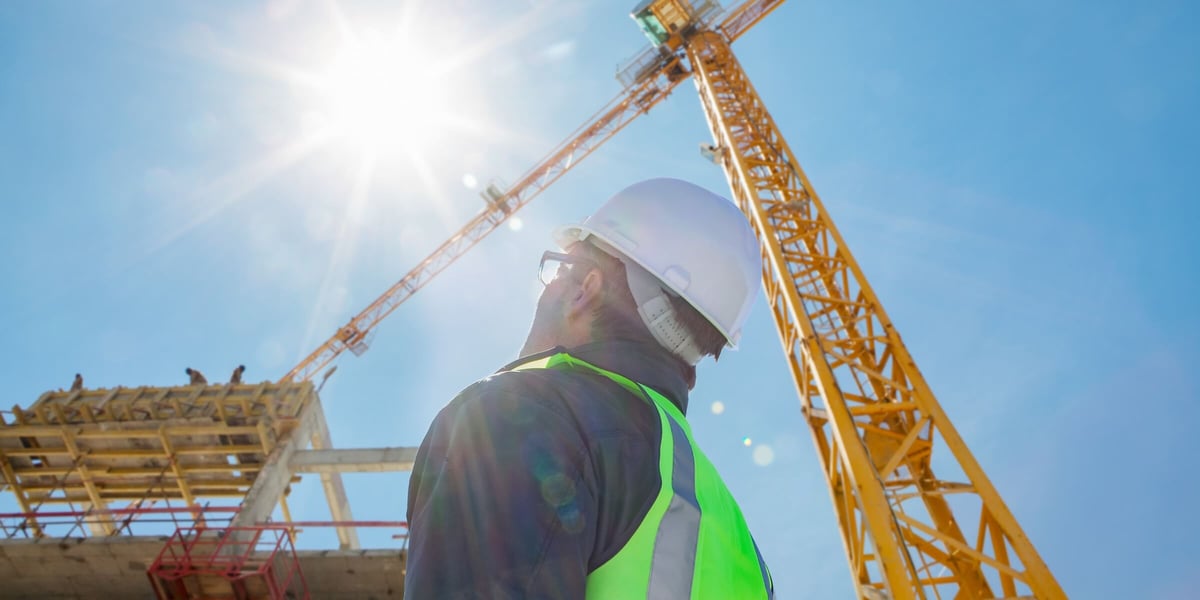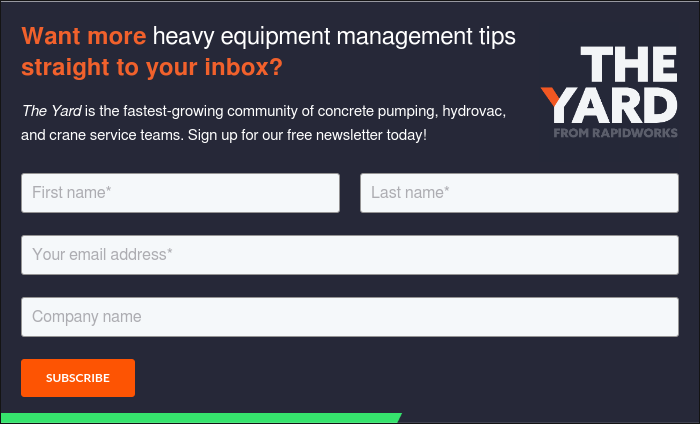How Controlling Entities Help Maintain Essential Crane Safety Standards

How Controlling Entities Help Maintain Essential Crane Safety Standards
Building up that all-important safety record is a great way to build trust with your employees, establish credibility in the industry, and attract new clients.
Occupational Safety and Health Administration (OSHA) crane regulations exist to keep your worksite safe and accident-free. You know this, but every now and then someone on your team might inadvertently skip an all-important safety step. This can threaten the high standards you pride yourself on.
One aspect of OSHA crane safety regulations that is important to recognize is the role of the "controlling entity." In this post, we will walk through what a controlling entity is, how they can keep your worksite safe, and how RapidWorks can help.
We'll cover:
What Is a Controlling Entity?
A controlling entity is an employer (usually a contractor, construction manager, or other legal entity) responsible for a construction project's planning, quality, and completion.
Simply put, a controlling entity has significant construction management experience and oversees the safety and quality of a worksite. Controlling entities work directly with management and employees to identify hazards, prevent accidents, and maintain quality standards.
Relevant OSHA Regulations for Controlling Entities
Controlling entities are an essential part of OSHA's General Duty Clause, which places responsibility for workplace safety in the hands of employers. Under these regulations, employers must identify and remove "recognized hazards that are causing or are likely to cause death or serious physical harm to his employees."
As you know, mobile cranes have numerous recognized hazards that can cause tragic accidents. Under OSHA, it's your responsibility as a manager to keep your employees safe from these hazards. Controlling entities are an essential piece of the safety puzzle on your worksite.
Controlling entities will identify potential risks or hazards, communicate them with relevant supervisors, and coordinate all safety and risk-prevention protocols. When it comes to crane safety, good communication is key. Crane owners and managers should understand the full responsibilities of the controlling entities on a safe worksite. This way, everyone will know who is responsible for what, and on-site communication will flow more easily.
The Roles and Responsibilities of a Controlling Entity
A controlling entity's roles and responsibilities can vary based on the specifics of each worksite. But in general, your controlling entity will have a few key areas of responsibility.
Verification of Ground Conditions
As you know, ground conditions are the foundation of safe crane operation — literally. Not only is this common sense, but it's also a critical OSHA crane safety regulation.
According to OSHA guidelines, crane operation grounds must be "firm, drained, and graded to a sufficient extent so that … the equipment manufacturer's specifications for adequate support and degree of level of the equipment are met."
In practice, this means your crane's grounds must be:
- Solid
- Even
- Free of obstacles
- Able to support the weight of the crane and any load
Operating mobile cranes on poor ground can cause dangerous tip-overs, collapses, or falls. The controlling entity will be primarily responsible for inspecting the ground on your worksite to ensure it meets the conditions for your mobile crane's specifications. A controlling entity can also identify any subsurface hazards, like underground power lines.
Site Inspection and Adjustments
When conditions change on your worksite, your operations need to adjust accordingly. For example, weather is often a safety issue on mobile crane worksites. Things like high winds, heavy rain, and lightning can pose significant dangers to your equipment and employees if you don't make proper adjustments.
The controlling entity will keep track of the weather, perform site inspections, and make critical adjustments if conditions take a turn for the worse. Controlling entities also work with crane operators and company managers to ensure that all cranes are appropriately placed and stabilized before use.
Hazard Identification
Mobile crane accidents tend to stem from a few common hazards. Common mobile crane safety hazards include:
- Boom failures or collapses
- Overloading
- Contact with power lines
- Tip-overs
- Falls from the crane equipment
- Structural failures
- Poor ground preparation
- Visual failures
A controlling entity is responsible for identifying these hazards before they become tragic accidents and communicating them to all relevant employees. For example, a controlling entity can double-check that a crane isn't overloaded beyond its maximum weight capacity before any excess weight causes a dangerous break or tip-over. Controlling entities should also identify potential overhanging hazards, like power lines or trees. Likewise, the controlling entity is responsible for providing the proper signage and markings to communicate potential hazards to crane operators.
While your operators are experienced professionals, they still have several blind spots that may prevent them from seeing potential hazards. A controlling entity confirms the worksite has sufficient signage communicating these hazards to your operators before accidents strike.
Maintaining Safe Access Routes
Mobile cranes need safe access routes to avoid dangerous collisions or tragic accidents between vehicles and people. One of the key responsibilities of your controlling entity is to identify and maintain these safe access routes before operations begin.
To do this, controlling entities will identify and remove any potential obstructions while checking to see if the ground conditions are good enough for your cranes to operate safely.
Controlling entities will also coordinate vehicle and pedestrian traffic on your worksite. This entails:
- Communicating directly with crane operators to account for potential blind spots and keeping other vehicles and pedestrians away from the crane
- Maintaining safe routes for both vehicle and pedestrian traffic around mobile cranes when they're operating
- Identifying any new hazards or weather conditions that may make the access routes unsafe
Collaboration and Communication
Finally, the controlling entity will facilitate effective communication between all major parties involved with a construction project. After all, mobile crane operations usually involve a crane owner, a site manager, multiple contractors, employees, and several other players.
Murky communication between any of these groups can easily cause accidents to occur. The controlling entity will help facilitate all communication and collaboration on a construction project to make sure important safety information doesn't get lost in the noise.
Penalties
You can think of your worksite's controlling entity as a fail-safe to avoid penalties for unsafe operating conditions and accidents. If you fail to meet mandatory OSHA safety standards, you'll likely incur costly fines and other penalties. Not only that, but accidents or injuries can also lead to lawsuits, settlements, and other civil penalties.
Best Practices for Collaboration
Once you cut through the legalese, the best practices for collaborating with controlling entities are no different from the standard crane safety practices you know well. Here are a few best practices to guarantee you get the most out of your worksite's controlling entity.
Establish Clear Communication
Always communicate clearly with your controlling entity, especially regarding relevant hazards or safety issues. Make sure they know about the ground conditions, overhead hazards, local traffic, and other safety issues long before your cranes go up.
Take Advantage of Your JHA
A job hazard analysis (JHA) is an exercise in which you identify anything and everything that might go wrong on a site before work begins. You and your controlling entity can work together on a comprehensive JHA to determine the most likely hazards on each worksite well beforehand.
Maintain Good Records and Documentation
Written documentation is always more reliable than verbal communication. Controlling entities can do their jobs more effectively with well-maintained communications, safety meetings, and agreement records. With RapidWorks' Visual Dispatch software, you can save all your relevant safety records in one place, making your controlling entity's job much easier.
Improve Your Safety and Collaboration With RapidWorks
While the crane owner is not the controlling entity on a worksite, each owner should still understand the controlling entity's roles and responsibilities to ensure workplace safety. You can prevent accidents involving your cranes before they occur by proactively collaborating with your controlling entities and fostering an environment of mutual respect, understanding, and cooperation.
Schedule a demo with RapidWorks today to see how our solutions can help keep your worksites safe and accident-free.
